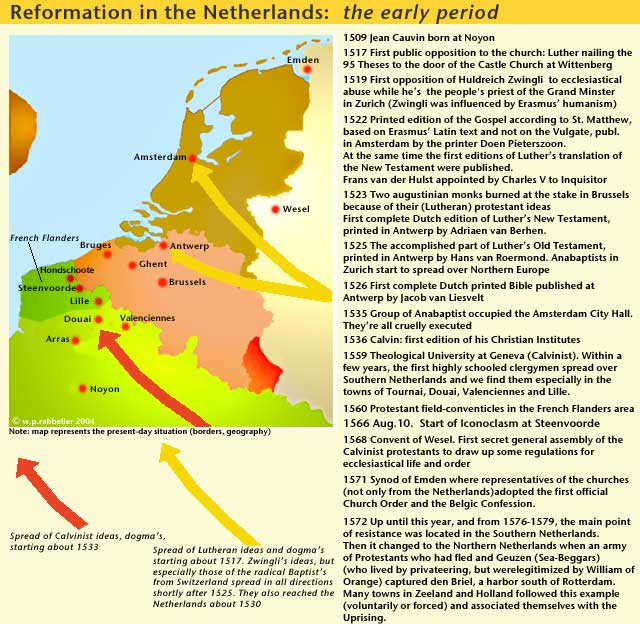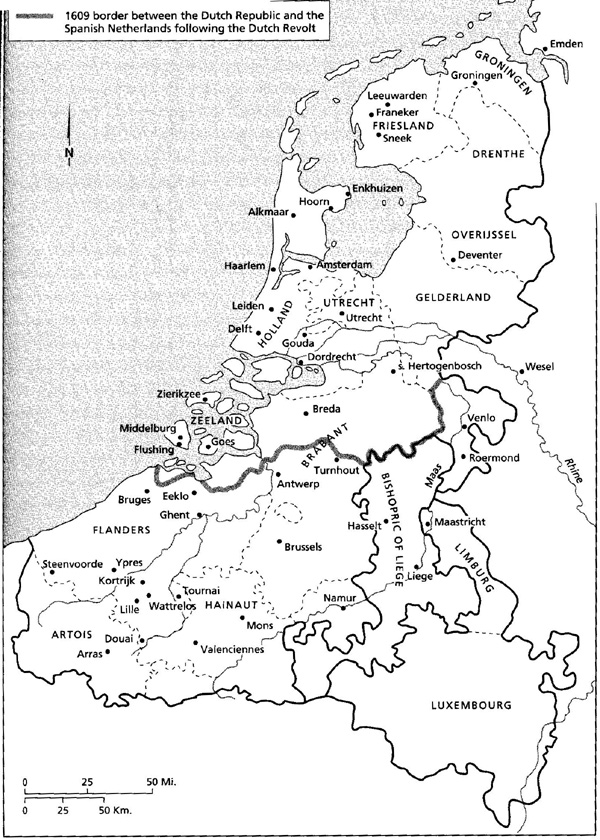The same forces that prepared the way for the Reformation in Germany and France were also at work in the Netherlands. In addition, there had been the influence of the Brothers of the Common Life in their effort to to reform the church and establish schools. The writings of Luther also became well known in the Netherlands, but the movement there was even more confused than in France. Of those who joined the movement, some were Lutheran, some were Zwinglians and others were Anabaptists. As in France, there was for a long time no unified leadership.
Because the Netherlands was close to Germany and their language was similar to Low German, the writings of Luther had great effect. Charles VI could respond directly in The Netherlands to this "infection" with the tools of the papal Inquisition and and at least 1300 Dutch were executed. By 1546 Lutheranism had been virtually wiped out in the Netherlands. Many survivors fled to England or German cities such as Emden, Wesel or Frankfurt where they were accepted as exiles.
At about the same time Menno Simons (1496-1561) was a Dutch religious reformer, from whom the religious body called Mennonites takes its name. Born at Witmarsum in Friesland, Menno was ordained a Roman Catholic priest in 1524. Doubts about transubstantiation, infant baptism, and other church dogmas led him to a close study of the New Testament and writings of Martin Luther. He gradually came to agree with Luther's position that the Bible should be the Christian's highest authority, and he left the Roman Catholic church. Although he opposed the revolutionary Anabaptists who led an unsuccessful uprising at Münster in 1535, his efforts to help them put him in danger of arrest, and he went into hiding for a year. In 1537 he became an Anabaptist preacher at Groningen, where he was married. In the following years he was active as a missionary, carrying the new faith to other parts of Friesland, to Zuid-Holland (South Holland), and Germany.
Menno adhered fundamentally to orthodox beliefs but rejected those that were not mentioned in the New Testament. He believed in the divinity of Christ and baptized only those who asserted their faith in Christ. In his view, military service and killing were unlawful, as were the taking of oaths, the holding of the office of magistrate, and marriage to persons outside the church. He also taught that prayer should be performed in silence. He differed from Luther and Calvin by defending the baptism of believers only, by teaching the doctrine of peace and nonresistance, and by rejecting the oath. He assumed the separation of church and state. He held to the Melchiorite doctrine of the incarnation, which taught that Christ brought to earth his own "heavenly flesh," receiving nothing from Mary, not even his humanity.
Again it was Calvin who brought order to the movement in the Netherlands. It was not until 1550 that the people began to feel the impact, but once Calvin's ideas became known, the Zwinglians and Anabaptists receded into the background. At first many students from the Netherlands had gone to Wittenberg, but now they began to study in Geneva. The Dutch Reformed churches took on Calvin's ideas about theology, church government, liturgy and the sovereignty of God in every sphere of life.
In 1544 a Reformed congregation was formed at Tournai in the south of the Netherlands with the help of some Swiss reformers. English refugees helped to form a church in Wesel in Germany. Other churches began to spring up: Antwerp in 1554, Valenciennes around 1560, and other cities.
The Church in the Netherlands also gave written expression to its faith, In 1561 Guido de Bres drew up a confession of faith, which is known as the Belgic Confession. Two years later, the Heidelberg Catechism, which had been written by Olevianus and Ursinus and published in Germany, was translated into Dutch. About this same time the Genevan Psalter was also translated into Dutch.
In 1567 de Bres was hanged in the town of Valencienne. Many persons suffered martyrdom for their faith as in the Netherlands. Charles V, Emperor of Germany, was also king of Spain and lord of the Netherlands. In his reign and the first years of the reign of his son Philip II, King of Spain (ruled 1556-1598) , more than 18,000 persons in the Netherlands fell victim to the Spanish Inquisition. In an attempt to force them to a confession of heresy both men and women were horribly tortured.
The tyranny and cruelty of King Philip II of Spain became unbearable. Spain was at that time the most powerful country in Europe. Holland was a very small country. But at last in 1568 the people of the Netherlands under the leadership of one of the greatest heroes of the Reformation, William the Silent, Prince of Orange, rose in revolt against Spain. The Calvinists of Holland became the champions of Protestantism for all the world. Through long dark days the Dutch went on fighting in the face of terrific odds. In 1584 William the Silent fell victim to an assassin's bullet.
Elizabeth, Queen of England, was friendly to the Protestant cause. Without declaring war against Spain, she had been lending aid to the Dutch, The Catholics had many plots to assassinate her, but all were in vain.
Now King Philiip of Spain formed a gradiose plan. He built an enormous fleet, which the Spanish called the "Invincible Armada." With this fleet he would invade England and with that country conquered, he thought it would be easy to put down the rebellion in The Netherlands. But the English with the help of the Dutch defeated the Spanish Armada. Only a miserable remnant of the once proud Armada returned to the ports of Spain.The power of Spain had suffered a terrible blow. The Dutch under Prince Maurice, son of William the Silent, continued the war until 1609 when Spain, in a Twelve Years' Truce, practically acknowledges the independence of the Northern Netherlands, the Dutch Republic.
Although usually not considered part of the Reformation, a third document was added to the Reformed creeds in 1618, when the Synod of Dordt reacted to the teaching of Armenius and proposed what came to be called the 5 points of Calvinism: Total depravity, Unconditional Election, Limited atonement, Irrestible grace and Perserverance of the saints. This document along with the Belgic Confession and the Heidelberg Catechism are often called the Three Forms of Unity in Reformed churches.


